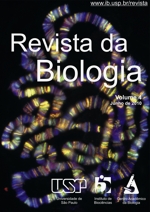Lipopolissacarídeo (LPS): ativador e regulador da transcrição gênica via fator de transcrição NFKB
DOI:
https://doi.org/10.11606/issn.1984-5154.v4p40-43Palavras-chave:
Regulação de expressão gênica, Lipopolissacarídeo, NFKBResumo
O LPS é o principal componente da membrana externa de bactérias gram-negativas e conhecido como importante ativador da resposta imunológica. Seus efeitos são mediados principalmente pelo NFKB, um fator de transcrição que se mantém inativo no citoplasma e que migra para o núcleo após a interação do LPS com seus receptores, promovendo a transcrição de diversos genes relacionados à resposta inflamatória aguda. Embora a resposta frente ao LPS seja bem compreendida, pouco se sabe a respeito dos pontos de regulação dessa resposta. Nesse sentido, descreveremos como o LPS se comunica com o meio intracelular, revisaremos os principais pontos conhecidos sobre a regulação da expressão de genes induzidos pelo NFKB e a participação desse fator e dos receptores de LPS na resposta inflamatória
Downloads
Referências
Akira, S., Takeda, K. (2004). Toll-like receptor signalling. Nat Rev Immunol. 4:499-511.
Baeuerle, P.A., Baltimore, D. (1996). NF-kappa B: ten years after. Cell, 87, 13-20.
Bonizzi, G., Karin, M. (2004). The two NF-kB activation pathways and their role in innate and adaptative immunity. Trends Immunol, 25, 280-288.
Carmody, R.J., Chen, Y.H. (2007). Nuclear Factor-kB: Activation and regulation during Toll-like receptor signaling. Cellular & Molecular Immunology. 4: 31-41.
Chen, L.F., Green, W.C. (2004). Shapping the nuclear action of NF-kB. Mol Cell Biol, 5, 392-401, 2004.
Duvernoy, H.M., Risold, P.Y. (2007). The circunventricular organs: An atlas of comparative anatomy and vascularization. Brains Research Reviews, 56, 119-147.
Ghosh, S., Hayden, M.S. (2008). New regulators of NF-kappaB in inflammation. Nat Rev Immunol, 11, 837-848.
Ghosh, S., Mary, M.J., Kopp, E.B. (1998). NF-kB and Rel proteins: evolutionarily conserved mediations of immune responses. Annu Rev Immunol, 16, 225-260.
Guha, M., Mackman, N. (2001). LPS induction of gene expression in human monocytes. Cellular Signaling, 13, 85-94.
Hayden, M.S., Ghosh, S. (2004). Signaling to NF-kappaB. Genes Dev, 18, 2195-2224.
Karin, M., Ben-Neriah, Y. (2000). Phosphorylation meets ubquitination: the control of NFkB activity. Annu Rev Immunol, 18:621-663.
Kawai, T., Akira, S. (2006). TLR signaling. Cell Death and Differentiation. 13:816–825.
Laflamme, N., Rivest, S. (2001). Toll-like receptor 4: The missing link of the cerebral innate immune response triggered by circulating gram-negative bacterial cell wal components. FASEB Journal, 15, 155-163.
Lu, Y.C., Yeh, W.C., Ohashi, P.S. (2008). LPS/TLR4 signal transduction pathway. Cytocine. 42: 145-151.
Meffert, M.K., Baltimore, D. (2005). Physiological functions for brain NF-κB. TRENDS in Neurosciences. 28: 27–43.
Nolan, G.P., Fujita, T., Bhatia, K., Huppi, C., Liou, H.C., Scott, M.L., Baltimore, D. (1993). The bcl-3 proto-oncogene encodes a nuclear I kappa B-lie molecule that preferentially interacts with NF-kappaB p50 and p52 in a phosphorylation-dependent manner. Mol Cell Biol, 13, 3557-3566.
Pahl, H.L., (1999). Activators and target genes of Rel/NF-kappaB transcription factors. Oncogene 18: 6853–6866.
Poltorak, A., He, X., Smirnova, I., Liu, M.Y., Van Huffel, C., Birdwell, D., Alejos, E., Silva, M., Galanos, C., Freudenberg, M., Ricciardi-Castagnoli, P., Layton, B., Beutler, B. (1998). Defective LPS signaling in C3H/HeJ and C57BL/10ScCr mice: mutatuions in tlr4 gene. Science. 282: 2085-2088.
Raetz, C.R., Whitfield, C. (2002). Lipopolysaccharide endotoxins. Annu Rev Biochem. 71: 635-700.
Rietschel, E.T., Kirikae, T., Shcade, F.U., Mamat, U., Schmidt, G., Loppnow, H., Ulmer, A.J., Zahringer, U., Seydel, U., Padova F.D., Schreier, M., Brade, H. (1994). Bacterial endotoxin: molecular relationships of structure to activity and function. FASEB J. 8:217-225.
Rivest, S. (2003). Molecular insights on the cerebral innate immune system. Brain, Behavior and Immunity, 17, 13-19.
Shen, A., Zhou, D., Shen, Q., Liu, H.O., Sun, L.L., Liu, Y., Chen, J., Yang, J., Ji, Y., Cheng, C. (2009). The expression of Tumor Necrosis Factor – alpha (TNF-alpha) by the intrathecal injection of Lipopolysaccharide in the rat spinal Cord. Neurochem Res. 34: 333-341.
Shimazu, R., Akashi, S., Ogata, H., Nagai, Y., Fukudome, K., Miyake, K., Kimoto, M. (1999). MD-2, a molecule that confers lipopolysaccharide responsiveness on Toll-like receptor 4. J Exp Med. 189: 1777-1782.
Siebenlist, U. (1997). NF kappa B/I kappa B proteins. Their role in cell growth, differentiation and development. Biochim Biophys Acta, 1332, 7-13.
Tuin, A., Vlag, A.H.V.D., Voenen-Weemaes A.M.M.A.V., Meijer, D.K.F., Poelstra K. (2006). On the role and fate of LPS-dephosphorylating activity in the rat liver. Am J Physiol Gastrointest Liver Physiol. 290: 377-385.
Walter, S., Letiembre, M., Liu Y., Heine, H., Penke, B., Hao, W., Bode, B., Manietta, N., Walter, J., Schulz-Schaffer, W., Fabender, K. (2007). Role of Toll-like receptor 4 in neuroinflammation in Alzheimer’s disease. Cell Physiol Biochem, 20, 947-956.
Downloads
Publicado
Edição
Seção
Licença
Copyright (c) 2010 Sanseray da Silveira Cruz-Machado

Este trabalho está licenciado sob uma licença Creative Commons Attribution 4.0 International License.
Salientamos que nossa revista não detém copyright, estes são exclusivos do autor do texto. Pretendemos com isso não criar entraves ao acesso do material publicado e atingir com mais intensidade nosso objetivo de divulgação da ciência.








 revistadabiologia@ib.usp.br
revistadabiologia@ib.usp.br 2008 - 2021 Revista da Biologia
2008 - 2021 Revista da Biologia